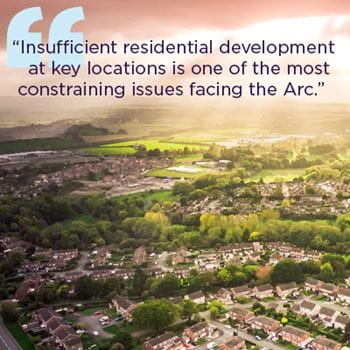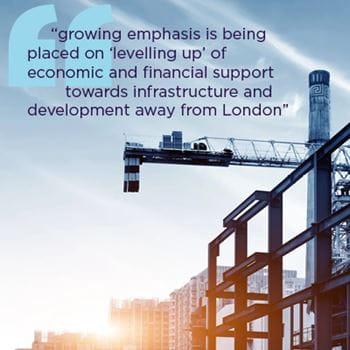In order for the Oxford Cambridge Arc to thrive and remain relevant, the following key themes should be actioned.
- Encouraging greater participation from private sector investors is a key opportunity. However, much of the excitement generated by the Arc proposals was based on the opportunity to develop along the new transport corridor, and in turn the costs of delivery infrastructure were predicated on development. There is now a considerable risk that uncertainty around infrastructure development, as well as perceived political interference and the wider economic uncertainty, may restrain the overall potential.
- The requirement to develop and create the correct balance of commercial space, ranging from SMEs to world renowned top specification companies, as well as meeting the changing requirements for property such as last mile delivery. This combination of accommodation is key to the future success of the vast array of businesses already existing within the Arc but also vital in terms of its future viability.
- Insufficient residential development at key locations is one of the most constraining issues facing the Oxford to Cambridge Arc. Focus on residential development opportunities at key arterial locations including Bedford, Milton Keynes, South Northamptonshire, St Neots, Sandy and Cambourne and South Oxfordshire and at the edge of both Oxford and Cambridge should be implemented in order to facilitate the essential increase in workforce required.
- A greater focus on existing corridors should be considered. These are established areas of skilled development and workforce which would significantly assist in the development of the Oxford Cambridge Corridor and be more cost efficient, practical and quicker than enhancing the east-west connections. Opportunities within Arc’s existing urban centres need to be maximised. For example, finding space to build strategic assets such as labs in Oxford and Cambridge city centres, taking advantage of the transition of demand away from retail and traditional offices, and any opportunities for intensification.
- There are many existing local transport proposals such as the Cowley branch line and the CAM Metro, which have the potential to open up significant areas of development in edge and out of town locations around the key Arc centres. Against a backdrop of falling funding, particularly for rail projects, the case for these to be implemented needs to be made.
- Detailed consideration of the development of an element of the Green Belt should now be given as this would lead to the quickest delivery of employment space and housing. This has the advantage of providing development in relatively close proximity to the key Arc city centres.
- Government focus and support is now required to enable the maximum volume of space to be delivered and the Arc’s profile to be capitalised. The government’s recent announcement on a spatial framework plan and a new Arc Growth Body is a significant endorsement for the Oxford-Cambridge Arc and will hopefully provide significant impetus to ensure its delivery and help to unleash its potential to be a global innovation powerhouse. While the concept of a cohesive area is welcomed, it will undoubtedly be a challenge to coordinate the various local planning authorities and the other statutory bodies that have jurisdiction and influence across the Arc.
- Encouraging greater participation from private sector investors is a key opportunity. However, much of the excitement generated by the Arc proposals was based on the opportunity to develop along the new transport corridor, and in turn the costs of delivering infrastructure were predicated on development. There is now a considerable risk that uncertainty around infrastructure development, as well as perceived political interference and the wider economic uncertainty, may restrain the overall potential.
- In light of the ongoing COVID-19 situation, growing emphasis is being placed on ‘levelling up’ of economic and financial support towards infrastructure and development away from the London and the South East and towards the North of the UK. Momentum on this issue is rising, and consequently, the Oxford Cambridge Arc is likely to face growing pressure towards its substantial proposals, particularly the east west rail link. The future and focus on the Arc may well materially change over the course of the next year.
Colin is a Partner and was appointed Head of Planning & Development Division in November 2020, he is based out of our Cambridge office. He has over 25 years’ experience of planning consultancy and has a broad sphere of work. He acts for a wide range of private, institutional and developer clients and has worked on significant planning applications and appeals.
Scott specialises in providing advice on agency and development matters to a wide variety of clients from private individuals and trusts through to property funds, institutions, companies and statutory authorities. He advises both owners and occupiers across public and private sectors.
Working at Board level with clients, Scott’s specialist areas include Business development, development of property strategies, property investment advice, advice in the marketing and disposal of property as well as property acquisitions.
Scott has a particular knowledge and understanding of the property market in the wider Oxfordshire region whilst also operating on a national basis on specific projects.








